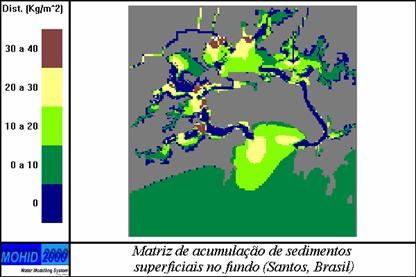MOHID Water
Sediments
Cohesive Sediment Dynamics

The Mohid model is able to simulate cohesive sediment transport, by combining the advection-diffusion module for simulating the transport in the water column and the free vertical movement module to compute the settling velocity, therefore the vertical displacement of the suspended particles. Processes like flocculation or hindered settling are considered to compute the settling velocity. The bottom module computes the erosion and deposition fluxes using typical critical shear stress formulation.
Mohid's cohesive sediment transport model influences other simulated particulate properties fate, becoming an important tool to compute contaminants transport and fate, due to the important percentage of these elements adsorbed on to cohesive sediments surface. Regarding the contaminant transport model, a sediment module was recently developed, in order to simulate its specific processes, meaning that the once deposited, cohesive sediment (and other properties adsorbed on to it) do not exit the modelled system and can continue to evolute, namely through consolidation and diagenetic processes.
The cohesive sediment transport model is currently being applied in an annular flume, using experimental data for validation.
Implementation
The implementation of the cohesive sediment transport model consists in tuning two different types of parameters. The first is the definition of the method to compute the settling velocity. The model considers two ways of computing the settling velocity: a constant velocity or using a formulation in which the velocity depends on the suspended cohesive sediment concentration, in order to account with the hindered settling.
Other parameters that must be tuned by the user are the critical shear stress of erosion and deposition. These parameters are responsible in controlling the fluxes of cohesive sediments between the water column and the bottom.



